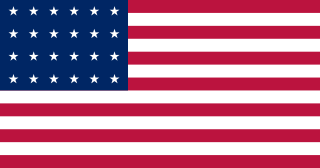
The Indian Territory and the Indian Territories are terms that generally describe an evolving land area set aside by the United States Government for the relocation of Native Americans who held aboriginal title to their land as a sovereign independent state. In general, the tribes ceded land they occupied in exchange for land grants in 1803. The concept of an Indian Territory was an outcome of the US federal government's 18th- and 19th-century policy of Indian removal. After the American Civil War (1861–1865), the policy of the US government was one of assimilation.

Kiowa people are a Native American tribe and an indigenous people of the Great Plains of the United States. They migrated southward from western Montana into the Rocky Mountains in Colorado in the 17th and 18th centuries, and finally into the Southern Plains by the early 19th century. In 1867, the Kiowa were moved to a reservation in southwestern Oklahoma.
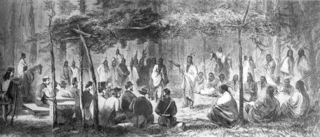
The Medicine Lodge Treaty is the overall name for three treaties signed near Medicine Lodge, Kansas, between the Federal government of the United States and southern Plains Indian tribes in October 1867, intended to bring peace to the area by relocating the Native Americans to reservations in Native American Territory and away from European-American settlement. The treaty was negotiated after investigation by the Indian Peace Commission, which in its final report in 1868 concluded that the wars had been preventable. They determined that the United States government and its representatives, including the United States Congress, had contributed to the warfare on the Great Plains by failing to fulfill their legal obligations and to treat the Native Americans with honesty.

The Comancheria or Comanchería is the region of New Mexico, west Texas and nearby areas occupied by the Comanche before the 1860s.
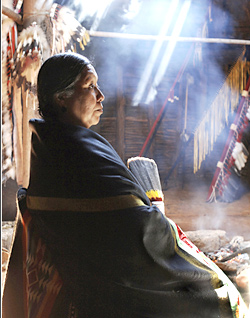
The Plains Apache are a small Southern Athabaskan group who live on the Southern Plains of North America, in close association with the linguistically unrelated Kiowa Tribe. Today, they are centered in Southwestern Oklahoma and Northern Texas and are federally recognized as the Apache Tribe of Oklahoma.
The American Indian Exposition, held annually during the first full week in August at the Caddo County Fairgrounds in Anadarko, Oklahoma, is one of the oldest and largest intertribal gatherings in the United States. Sponsored by fifteen tribes, representatives from up to fifty other tribes participate in any given year.
The Indian City USA Cultural Center, formerly known as Indian City USA, was an outdoor museum in Anadarko, Oklahoma.

The Institute of American Indian Arts (IAIA) is a Public tribal land-grant college in Santa Fe, New Mexico. The college focuses on Native American art. It operates the Museum of Contemporary Native Arts (MoCNA), which is housed in the historic Santa Fe Federal Building, a landmark Pueblo Revival building listed on the National Register of Historic Places as Federal Building. The museum houses the National Collection of Contemporary Indian Art, with more than 7,000 items.
The Fort Sill Apache Tribe is the federally recognized Native American tribe of Chiricahua Warm Springs Apache in Oklahoma.
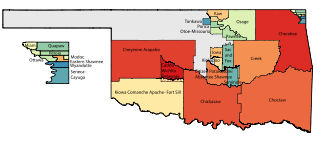
Oklahoma Tribal Statistical Area is a statistical entity identified and delineated by federally recognized American Indian tribes in Oklahoma as part of the U.S. Census Bureau's 2010 Census and ongoing American Community Survey. Many of these areas are also designated Tribal Jurisdictional Areas, areas within which tribes will provide government services and assert other forms of government authority. They differ from standard reservations, such as the Osage Nation of Oklahoma, in that allotment was broken up and as a consequence their residents are a mix of native and non-native people, with only tribal members subject to the tribal government. At least five of these areas, those of the so-called five civilized tribes of Cherokee, Choctaw, Chickasaw, Creek and Seminole, which cover 43% of the area of the state, are formally recognized as reservations by federal treaty, and thus not subject to state law or jurisdiction for tribal members.

Marcelle Sharron Ahtone Harjo is a Kiowa painter from Oklahoma. Her Kiowa name, Sain-Tah-Oodie, translates to "Killed With a Blunted Arrow." In the 1960s and 1970s, she and sister Virginia Stroud were instrumental in the revival of ledger art, a Plains Indian narrative pictorial style on paper or muslin.
David Emmett Williams was a Native American painter, who was Kiowa/Tonkawa/Kiowa-Apache from Oklahoma. He studied with Dick West at Bacone College and won numerous national awards for his paintings. He painted in the Flatstyle technique that was taught at Bacone from the 1940s to the 1970s.
Doris Littrell (1929–2020) was a gallerist from central Oklahoma who promoted Native American art.

Josephine Myers-Wapp was a Comanche weaver and educator. After completing her education at the Haskell Institute, she attended Santa Fe Indian School, studying weaving, dancing, and cultural arts. After her training, she taught arts and crafts at Chilocco Indian School before joining the faculty of the newly opened Institute of American Indian Arts in Santa Fe. She taught weaving, design, and dance at the Institute, and in 1968 was one of the coordinators for a dance exhibit at the Mexican Summer Olympic Games. In 1973, she retired from teaching to focus on her own work, exhibiting throughout the Americas and in Europe and the Middle East. She has work in the permanent collection of the IAIA and has been featured at the Smithsonian Institution. Between 2014 and 2016, she was featured in an exhibition of Native American women artists at the Museum of Indian Arts and Culture in Santa Fe.
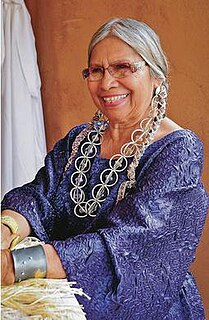
Jeri Ah-be-hill was a Kiowa fashion expert and art dealer. She owned and operated a trading post on the Wind River Indian Reservation for more than twenty years before moving to Santa Fe, New Mexico where she became the curator of the annual Native American Clothing Contest held at the Santa Fe Indian Market. She also worked as a docent at both the Institute of American Indian Arts and the Wheelwright Museum of the American Indian. Considered an expert on Native American fashion, she traveled nationally presenting educational information about tribal clothing.

Georgeann Robinson was an Osage teacher and businesswoman, who used her skill with ribbonwork to preserve the cultural heritage of her people. She was honored as a 1982 National Heritage Fellowship recipient by the National Endowment for the Arts and has works in the permanent collections of the Metropolitan Museum of Art in Manhattan, Museum of International Folk Art of Santa Fe, New Mexico and in the Southern Plains Indian Museum in Anadarko, Oklahoma. As an activist, from 1958, she was active in the National Congress of American Indians and in the late 1960s, was the executive vice president of the organization.
Mary Adair is a Cherokee Nation educator and painter. After completing her education, she first taught school and then worked in youth programs. She served as the director of the Murrow Indian Children's Home at Bacone College and directed for the Cherokee Nation Jobs Corp Center before becoming the art instructor at Sequoyah High School in Tahlequah, Oklahoma.
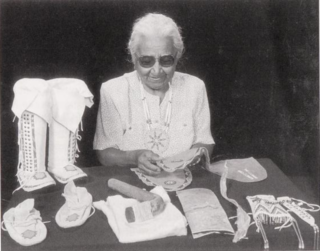
Alice Littleman was a Kiowa beadwork artist and regalia maker, who during her life time was recognized as one of the leading Kiowa beaders and buckskin dressmakers. Her works are included in the permanent collections of the National Museum of Natural History, the National Museum of the American Indian, the Southern Plains Indian Museum, and the Oklahoma Historical Society.












